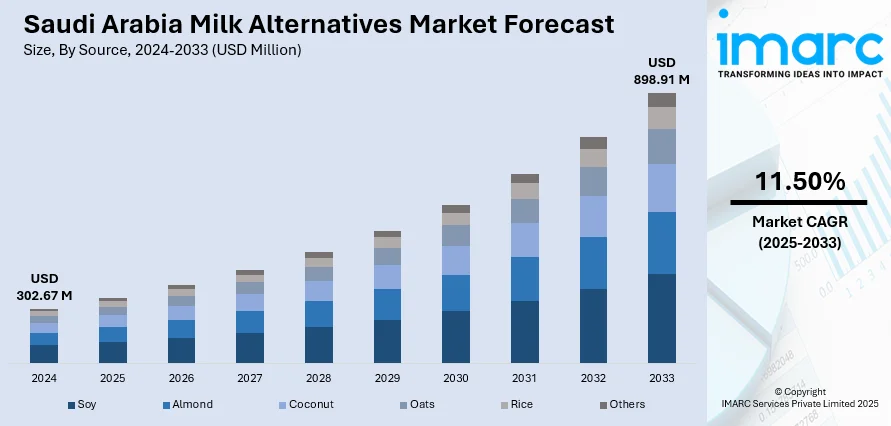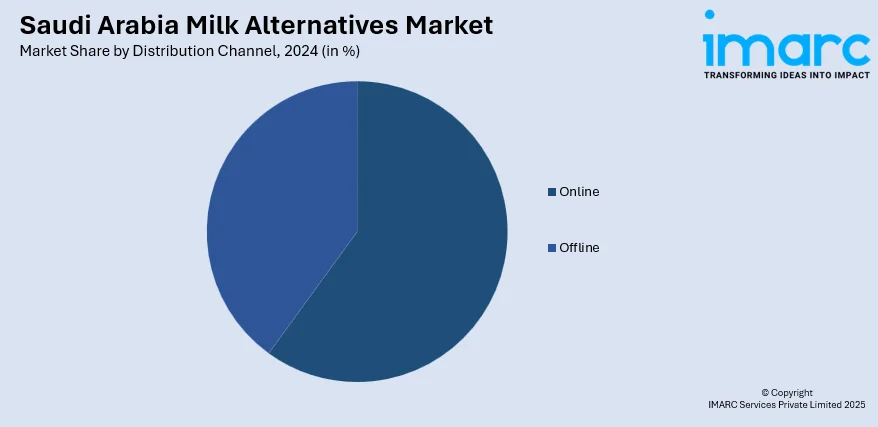
Saudi Arabia Milk Alternatives Market Size, Share, Trends and Forecast by Source, Flavor, Packaging, Distribution Channel, and Region, 2025-2033
Saudi Arabia Milk Alternatives Market Overview:
The Saudi Arabia milk alternatives market size reached USD 302.67 Million in 2024. Looking forward, IMARC Group expects the market to reach USD 898.91 Million by 2033, exhibiting a growth rate (CAGR) of 11.50% during 2025-2033. The market is driven by growing demand for health-oriented dietary options, alignment with halal and ethical consumer values, and expanded access through modernized retail channels. Continued retail innovations and cultural compatibility are reshaping buyer behavior and solidifying category presence across the country, further augmenting the Saudi Arabia milk alternatives market share.
|
Report Attribute
|
Key Statistics
|
|---|---|
|
Base Year
|
2024 |
|
Forecast Years
|
2025-2033
|
|
Historical Years
|
2019-2024
|
| Market Size in 2024 | USD 302.67 Million |
| Market Forecast in 2033 | USD 898.91 Million |
| Market Growth Rate 2025-2033 | 11.50% |
Saudi Arabia Milk Alternatives Market Trends:
Rising Health Consciousness and Dietary Shifts in Saudi Arabia
Health and nutrition have become central themes in consumer decision-making across Saudi Arabia. Driven by rising rates of obesity, diabetes, and cardiovascular conditions, more individuals are actively adjusting their diets, cutting back on processed and high-fat foods, and exploring alternatives to conventional staples. Dairy, once considered essential in most households, is now facing reduced consumption, especially among those seeking lighter or plant-based options. Government-led health campaigns, including calorie labeling regulations and sugar taxes, have reinforced this behavior, encouraging consumers to reconsider traditional dietary habits. Milk alternatives, especially almond, soy, and oat-based products, are now seen as suitable choices for those pursuing weight control or managing food sensitivities, particularly lactose intolerance, which affects a significant portion of the population. Local and international brands have responded with product offerings that emphasize natural ingredients, no added sugar, and enhanced nutritional profiles. Health-focused retailers, fitness influencers, and digital wellness platforms have further shaped consumer preferences, introducing younger demographics to plant-based lifestyles. These changing patterns have significantly influenced purchasing behavior and positioned milk alternatives as a core component of better-for-you diets, driving sustained Saudi Arabia milk alternatives market growth.

Religious and Ethical Consumer Considerations
In Saudi Arabia, dietary choices are not just personal but often shaped by cultural and religious values. Shariah compliance and halal certification are non-negotiable requirements for food products, and plant-based milk alternatives naturally align with these expectations. Consumers seeking halal-certified, ethical, and animal-free products often turn to alternatives that are not only compliant but also seen as cleaner and more transparent in sourcing. This consideration extends beyond food into a broader demand for ethical consumption, particularly among younger Saudis who are active on social media and more globally connected. Milk alternatives, generally free from animal-derived enzymes or additives, are perceived as easier to trust and validate from a compliance perspective. Many international plant-based brands entering the Saudi market ensure their products meet halal standards from production to packaging. Ethical sourcing and transparent labeling practices resonate strongly in this environment. Meanwhile, the growing popularity of cruelty-free, vegan, and eco-conscious lifestyles is gradually gaining visibility, further reinforcing demand for milk alternatives that meet both faith-based and ethical expectations. This alignment with religious and moral values continues to shape brand preference and consumer loyalty within this segment.
Retail Modernization and Product Availability
The Saudi retail sector has undergone rapid modernization, driven by Vision 2030 reforms and increasing private sector investment. Large-format supermarkets, hypermarkets, and specialty health stores are now widespread, especially in urban centers such as Riyadh, Jeddah, and Dammam. This transformation has significantly improved accessibility to global food trends, including plant-based milk products. Where once availability was limited to niche outlets or imported specialty goods, major retail chains now stock a growing variety of milk alternatives. This includes both international labels and emerging regional producers catering to local tastes. E-commerce has played an equally important role. Online grocery platforms and health-focused digital retailers offer broader assortments, often with subscription models and home delivery options. Promotions, in-store tastings, and social media campaigns have raised consumer awareness and normalized the purchase of plant-based beverages. Coffee chains and boutique cafes have also contributed by routinely offering milk alternatives as standard, which encourages trial and drives consumer familiarity. As the retail landscape becomes more efficient and diversified, the availability and visibility of milk alternatives are expected to continue expanding, reinforcing category relevance and volume growth.
Saudi Arabia Milk Alternatives Market Segmentation:
IMARC Group provides an analysis of the key trends in each segment of the market, along with forecasts at the country and regional levels for 2025-2033. Our report has categorized the market based on source, flavor, packaging, and distribution channel.
Source Insights:
- Soy
- Almond
- Coconut
- Oats
- Rice
- Others
The report has provided a detailed breakup and analysis of the market based on the source. This includes soy, almond, coconut, oats, rice, and others.
Flavor Insights:
- Flavored
- Unflavored
The report has provided a detailed breakup and analysis of the market based on the flavor. This includes flavored and unflavored.
Packaging Insights:
- Cartons
- Glass bottles
- Others
The report has provided a detailed breakup and analysis of the market based on the packaging. This includes cartons, glass bottles, and others.
Distribution Channel Insights:

- Online
- Offline
The report has provided a detailed breakup and analysis of the market based on the distribution channel. This includes online and offline.
Regional Insights:
- Northern and Central Region
- Western Region
- Eastern Region
- Southern Region
The report has also provided a comprehensive analysis of all major regional markets. This includes Northern and Central Region, Western Region, Eastern Region, and Southern Region.
Competitive Landscape:
The market research report has also provided a comprehensive analysis of the competitive landscape. Competitive analysis such as market structure, key player positioning, top winning strategies, competitive dashboard, and company evaluation quadrant has been covered in the report. Also, detailed profiles of all major companies have been provided.
Saudi Arabia Milk Alternatives Market Report Coverage:
| Report Features | Details |
|---|---|
| Base Year of the Analysis | 2024 |
| Historical Period | 2019-2024 |
| Forecast Period | 2025-2033 |
| Units | Million USD |
| Scope of the Report |
Exploration of Historical Trends and Market Outlook, Industry Catalysts and Challenges, Segment-Wise Historical and Future Market Assessment:
|
| Sources Covered | Soy, Almond, Coconut, Oats, Rice, Others |
| Flavors Covered | Flavored, Unflavored |
| Packagings Covered | Cartons, Glass bottles, Others |
| Distribution Channels Covered | Online, Offline |
| Regions Covered | Northern and Central Region, Western Region, Eastern Region, Southern Region |
| Customization Scope | 10% Free Customization |
| Post-Sale Analyst Support | 10-12 Weeks |
| Delivery Format | PDF and Excel through Email (We can also provide the editable version of the report in PPT/Word format on special request) |
Key Questions Answered in This Report:
- How has the Saudi Arabia milk alternatives market performed so far and how will it perform in the coming years?
- What is the breakup of the Saudi Arabia milk alternatives market on the basis of source?
- What is the breakup of the Saudi Arabia milk alternatives market on the basis of flavor?
- What is the breakup of the Saudi Arabia milk alternatives market on the basis of packaging?
- What is the breakup of the Saudi Arabia milk alternatives market on the basis of distribution channel?
- What is the breakup of the Saudi Arabia milk alternatives market on the basis of region?
- What are the various stages in the value chain of the Saudi Arabia milk alternatives market?
- What are the key driving factors and challenges in the Saudi Arabia milk alternatives market?
- What is the structure of the Saudi Arabia milk alternatives market and who are the key players?
- What is the degree of competition in the Saudi Arabia milk alternatives market?
Key Benefits for Stakeholders:
- IMARC’s industry report offers a comprehensive quantitative analysis of various market segments, historical and current market trends, market forecasts, and dynamics of the Saudi Arabia milk alternatives market from 2019-2033.
- The research report provides the latest information on the market drivers, challenges, and opportunities in the Saudi Arabia milk alternatives market.
- Porter's five forces analysis assist stakeholders in assessing the impact of new entrants, competitive rivalry, supplier power, buyer power, and the threat of substitution. It helps stakeholders to analyze the level of competition within the Saudi Arabia milk alternatives industry and its attractiveness.
- Competitive landscape allows stakeholders to understand their competitive environment and provides an insight into the current positions of key players in the market.
Need more help?
- Speak to our experienced analysts for insights on the current market scenarios.
- Include additional segments and countries to customize the report as per your requirement.
- Gain an unparalleled competitive advantage in your domain by understanding how to utilize the report and positively impacting your operations and revenue.
- For further assistance, please connect with our analysts.
 Request Customization
Request Customization
 Speak to an Analyst
Speak to an Analyst
 Request Brochure
Request Brochure
 Inquire Before Buying
Inquire Before Buying




.webp)




.webp)












